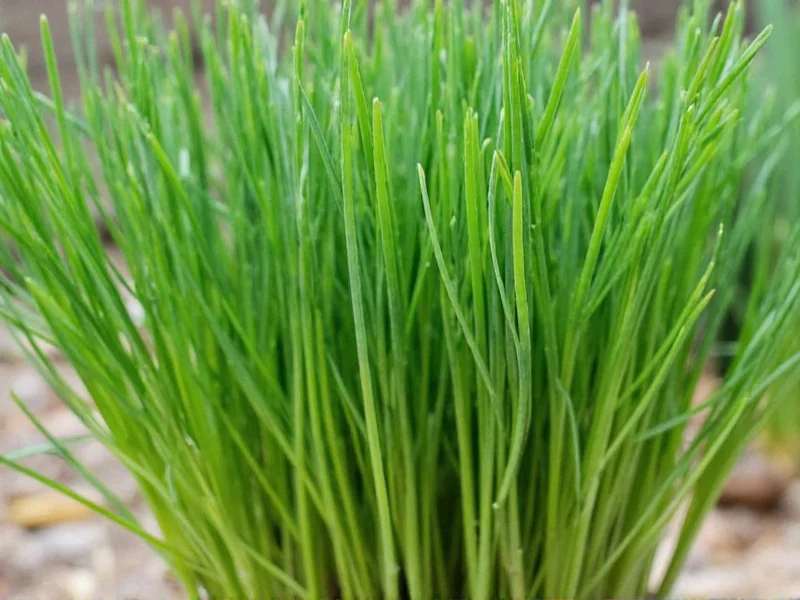When you're exploring what are fresh chives, you're looking at one of the most delicate members of the Allium genus. These slender green tubes grow in clumps from small bulbs and feature a subtle onion flavor that's significantly milder than their onion or garlic relatives. The entire green stalk is edible, though the lower portion near the bulb has a slightly stronger taste.
Visual Identification and Characteristics
Fresh chives appear as uniform green cylinders, typically 6-12 inches long with a diameter of about 1/8 inch. They maintain a consistent thickness from base to tip, distinguishing them from green onions which have a thicker white bulb section. When cut, they release a pleasant, mild onion aroma rather than the pungent scent of mature onions. The cross-section reveals a perfect circle, unlike garlic chives which are flat.
| Characteristic | Fresh Chives | Green Onions | Garlic Chives |
|---|---|---|---|
| Shape | Hollow, round tubes | Round with bulb | Flat, solid blades |
| Flavor Profile | Mild onion | Stronger onion | Garlic notes |
| Flower | Purple pom-poms | None | White star-shaped |
| Best Culinary Use | Finishing touch | Cooking base | Asian dishes |
Flavor Profile and Culinary Applications
Understanding what do fresh chives taste like is essential for proper culinary application. They deliver a delicate onion essence without the sharp bite of mature onions, making them perfect for dishes where you want subtle allium flavor without overwhelming other ingredients. Heat diminishes their flavor significantly, which is why chefs consistently recommend adding fresh chives after cooking as a garnish rather than during the cooking process.
Professional kitchens use fresh chives to elevate dishes like scrambled eggs, baked potatoes, cream sauces, and seafood preparations. Their vibrant green color provides visual appeal that dried chives cannot match. When properly chopped (using sharp scissors to avoid bruising), they distribute evenly through dishes without creating unpleasant onion chunks.
Nutritional Benefits of Fresh Chives
Fresh chives offer more than just flavor—they're packed with nutritional value often overlooked when considering what are fresh chives used for beyond garnish. These slender greens contain vitamin K (essential for blood clotting), vitamin C (an antioxidant), and notable amounts of allicin compounds that support cardiovascular health. One tablespoon of chopped fresh chives provides approximately:
- 1% of daily vitamin A needs
- 4% of daily vitamin C requirements
- 14% of your vitamin K needs
- Trace minerals including calcium and iron
Unlike many herbs, chives maintain their nutritional profile even when used in small quantities due to their high concentration of beneficial compounds per gram.
Proper Storage Techniques for Maximum Freshness
Learning how to store fresh chives properly extends their shelf life from days to weeks. The optimal method involves treating them like cut flowers: trim the ends, place in a glass with 1-2 inches of water, cover loosely with a plastic bag, and refrigerate. Change the water every 2-3 days. This technique maintains crispness and prevents the slimy texture that develops when chives are stored directly in plastic bags.
For longer preservation, many chefs recommend freezing chives in olive oil within ice cube trays—a method that preserves both flavor and texture better than drying. When properly stored using these techniques, fresh chives maintain peak quality for 10-14 days, significantly longer than the typical 3-5 days with improper storage.
Common Substitutions and Mistakes to Avoid
When exploring fresh chives substitution options, understand that no alternative perfectly replicates their unique flavor profile. Dried chives lose 90% of their aromatic compounds and should be used at a 1:3 ratio (1 part dried to 3 parts fresh). Green onions can substitute in a pinch but require using only the green portions and reducing quantity by half due to stronger flavor.
The most common mistake home cooks make is adding fresh chives too early in the cooking process. Their delicate flavor compounds break down rapidly with heat exposure. Always add them in the final minute of cooking or as a finishing garnish. Another frequent error involves improper chopping technique—using a knife instead of scissors creates bruised edges that turn the chives mushy and accelerate spoilage.
Seasonal Availability and Selection Tips
Fresh chives reach peak quality in spring and early summer, though greenhouse varieties make them available year-round. When selecting chives at the market, look for uniformly green stalks without yellowing or wilting. The best specimens stand upright when held horizontally, indicating proper hydration and freshness. Avoid bundles with slimy texture or dark spots, which indicate age and improper storage.
For gardeners interested in growing fresh chives at home, these hardy perennials thrive in containers with minimal care. They're among the first herbs to emerge in spring and continue producing harvests through fall with regular trimming. Homegrown chives typically offer superior flavor to store-bought varieties due to immediate use after harvesting.











 浙公网安备
33010002000092号
浙公网安备
33010002000092号 浙B2-20120091-4
浙B2-20120091-4